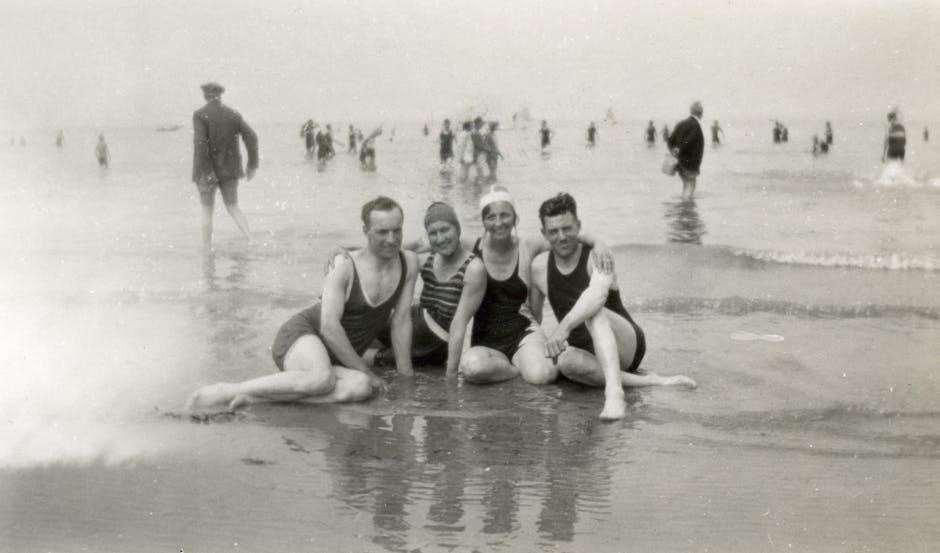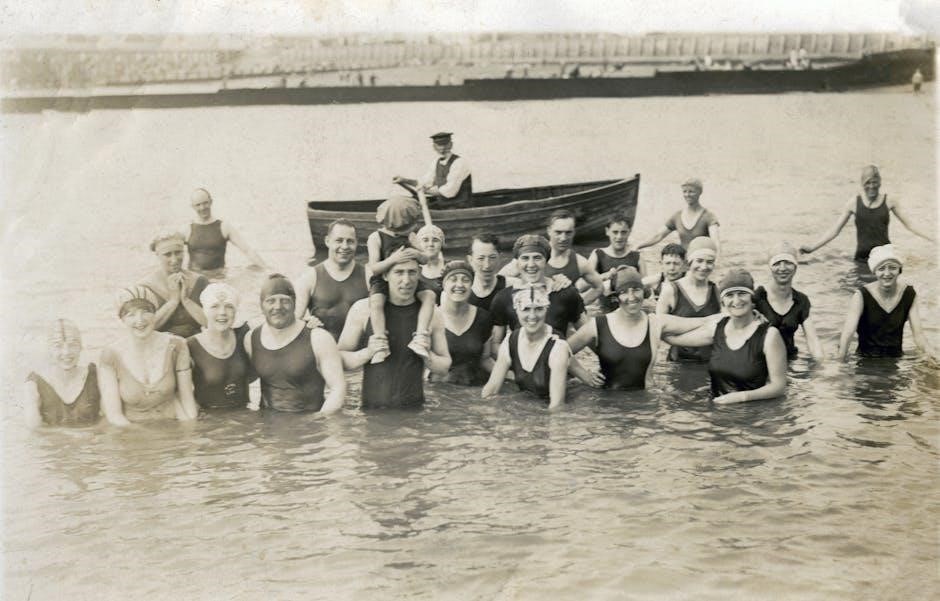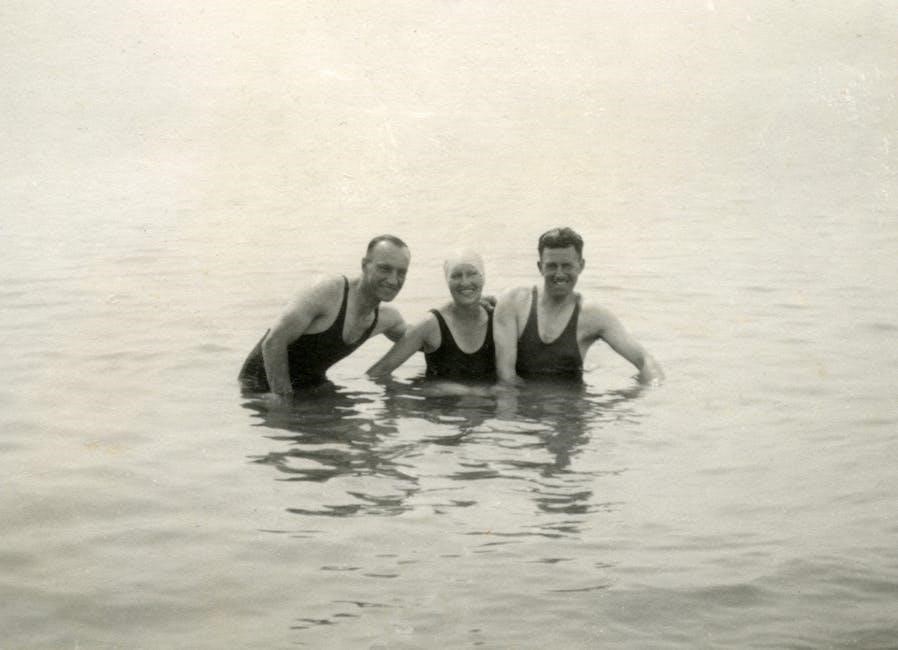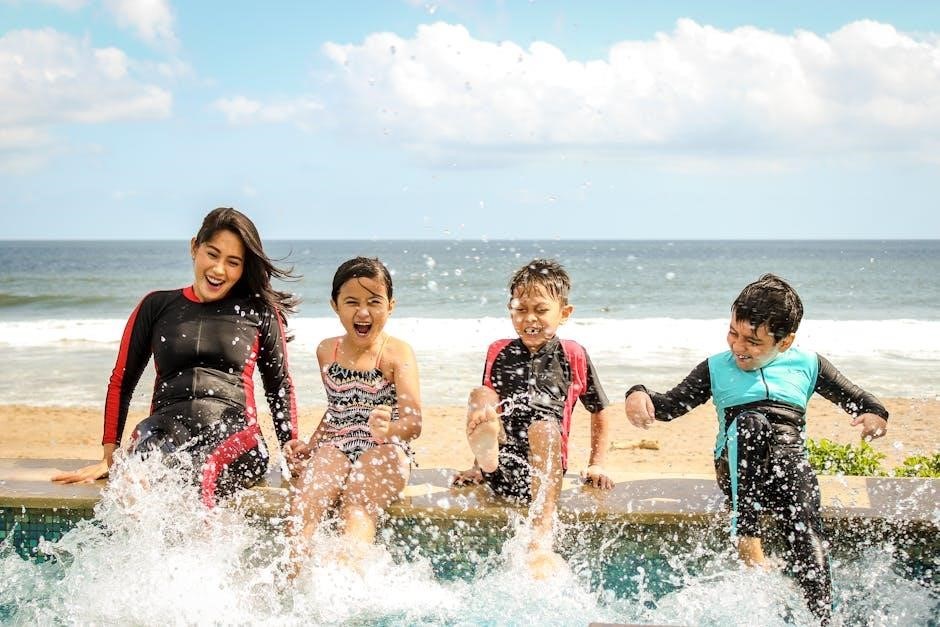Age group swim workouts are structured training programs designed for swimmers of specific age ranges, focusing on technique, endurance, and fun, with adaptable plans for skill development and engagement․
Definition and Importance of Age Group Workouts
Age group workouts are structured swim training programs tailored to specific age ranges, focusing on skill development, endurance, and technique․ These workouts are essential for young swimmers, as they provide a progressive approach to improving swimming abilities while fostering teamwork and discipline․ By catering to different developmental stages, age group workouts ensure swimmers build a strong foundation, preparing them for competitive swimming and lifelong love for the sport․ Coaches adapt drills, intensity, and volume to suit the age and skill level of participants, promoting balanced growth and achievement․

Benefits of Age-Specific Training
Age-specific training enhances skill mastery, boosts efficiency, and prevents injuries by tailoring workouts to developmental needs, ensuring optimal progress and engagement for swimmers of all ages․

Physical and Developmental Considerations
Age group workouts must account for varying physical and developmental stages, such as growth spurts and body changes, ensuring exercises are age-appropriate and injury-preventative․ For younger swimmers, focus on basic movement skills and water acclimation, while older athletes benefit from more intense conditioning․ Technique development is critical at all stages to build a strong foundation and promote long-term progress․ Incorporating drills that improve flexibility, strength, and coordination ensures swimmers grow into capable and confident athletes․
Additionally, practices should be tailored to energy levels and attention spans, balancing fun with structured learning to maintain engagement and motivation across different age groups․

Structure of a Typical Workout Plan
A typical age group workout plan includes a warm-up, drills, main sets focusing on endurance and technique, and a cool-down with stretching to prevent injuries․
Warm-Up, Drills, and Main Sets
A typical age group workout begins with a dynamic warm-up, including light cardio and stretching to prepare muscles․ Drills focus on stroke technique, such as freestyle long-axis exercises and backstroke delay pulls․ Main sets target endurance with interval training and distance swims, adjusted by age and ability․ For example, younger swimmers might start with shorter intervals like 25s or 50s, while older groups tackle longer distances․ Cool-downs involve stretching to promote recovery and prevent injury, ensuring a balanced and effective session for all skill levels․
Incorporating Drills for Technique Development
Drills enhance stroke efficiency and body positioning, with exercises like one-arm and fingertip drag focusing on proper mechanics, improving overall swimming technique and performance in age group workouts․
Focus on Freestyle and Backstroke
Freestyle and backstroke drills are fundamental in age group workouts, emphasizing long-axis techniques․ For freestyle, swimmers practice high-elbow catches and strong kicks, while backstroke focuses on body rotation and arm timing․ These drills improve efficiency and endurance, essential for competitive swimming․ Coaches often incorporate snorkel use to enhance stroke control, ensuring young athletes develop proper form and consistency․ Such targeted exercises help build a strong foundation for advanced swimming skills․
Mastering Butterfly and Breaststroke
Butterfly and breaststroke require precise timing and coordination․ Drills like one-arm butterfly and alternating kicks help swimmers develop rhythm․ For breaststroke, focus on explosive kicks and smooth arm pulls․ Coaches often incorporate strength exercises to enhance power․ These strokes demand core engagement and controlled breathing, which are critical for efficiency․ Mastery of these techniques boosts overall swimming performance and prepares athletes for more advanced training․ Proper form and consistency are emphasized to reduce injury risk and improve endurance․
Building Endurance and Stamina
Building endurance and stamina involves interval training and distance swimming․ These techniques improve speed, increase stamina, and prepare swimmers for competitive demands․
Interval Training and Distance Swimming
Interval training and distance swimming are key components of building endurance in age group swim workouts․ Interval training involves short, high-intensity swims with rest periods, improving speed and stamina․ Distance swimming focuses on longer, steady-paced swims to enhance cardiovascular fitness and muscular endurance․ Coaches often combine these methods to tailor workouts for different age groups, ensuring swimmers gradually build stamina․ For example, younger athletes might start with shorter intervals, while older swimmers can handle more intense or longer sets․ These techniques prepare swimmers for competitive demands and improve overall performance․
Injury Prevention and Recovery
Injury prevention and recovery are crucial in age group swim workouts, emphasizing proper stretching, strength exercises, and techniques to maintain swimmer health and optimize performance levels․
Stretching and Strength Exercises
Stretching and strength exercises are essential for injury prevention in age group swimmers․ Dynamic stretching, such as arm circles and leg swings, improves flexibility and reduces injury risk․ Post-workout static stretches, like hamstring and shoulder stretches, enhance recovery․ Strength exercises, including core and shoulder work, build resilience․ Dry-land exercises like push-ups and planks are effective․ These routines, done 2-3 times weekly, promote overall athletic development and swimming efficiency․ Proper form and age-appropriate intensity ensure safety and effectiveness for young athletes․ Resources like the 30-Day Abs Challenge PDF offer additional guidance․
Role of Dry-Land Training
Dry-land training enhances swimming performance by improving strength, flexibility, and endurance through exercises like push-ups and planks, complementing pool work and preventing injuries in age group swimmers․
Strength and Conditioning Exercises
Strength and conditioning exercises are vital for age group swimmers, enhancing power and endurance․ Push-ups, planks, and resistance band workouts target upper body strength and core stability․ Dynamic movements like high knees and arm circles improve flexibility and coordination․ These exercises also prevent injuries by strengthening shoulders and improving posture․ Swim-specific drills, such as medicine ball throws and box jumps, mimic swimming motions, boosting explosiveness and technique․ A well-rounded dry-land routine complements pool training, ensuring swimmers develop the endurance and power needed for competitive performance while staying injury-free and motivated throughout the season․

Season Planning and Periodization
Season planning involves structuring workouts yearly, using periodization to prevent overtraining and optimize performance, ensuring swimmers peak at key competitions while staying motivated and injury-free․
Structuring Workouts Throughout the Year
Workouts are divided into phases, such as foundational, intensity, and competition preparation, with periodization ensuring balanced training․ Coaches adapt plans to suit age groups, focusing on physical development and technical refinement․ Younger swimmers emphasize skill acquisition, while older athletes build endurance and power․ Seasonal goals guide weekly schedules, with rest and recovery integrated to prevent overtraining․ This structured approach ensures progressive improvement, keeping swimmers motivated and prepared for key competitions throughout the year while maintaining long-term development․

Motivation and Engagement
Motivation is key in age group workouts, achieved through fun drills, positive encouragement, and goal setting, ensuring young swimmers stay engaged and committed to their development journey․
Keeping Young Athletes Motivated
Motivating young athletes involves creating a positive environment with fun, varied drills and achievable goals․ Encouraging stroke efficiency and advanced training skills fosters engagement and excitement․ Coaches should focus on team interaction, celebrating progress, and providing constructive feedback to keep swimmers enthusiastic․ Incorporating elements of competition and recognition, such as time trials or awards, can also boost morale․ Making practice enjoyable while introducing new challenges helps maintain their interest and commitment to improving their swimming abilities over time․

Case Studies and Examples
Successful age group workout plans, like those by Cal Bentz, involve structured drills, interval training, and technique focus․ These plans have proven to enhance swimmers’ performance and engagement, achieving desired results in both skill development and team motivation, as seen in various competitive settings and documented improvements in swim times and stroke efficiency across different age groups, ensuring a well-rounded approach to swimming excellence and athlete growth․
Successful Age Group Workout Plans
Effective age group workout plans, such as those designed by Cal Bentz, incorporate structured drills, interval training, and technique-focused exercises․ These plans are tailored to swimmers aged 13-17, with workouts held Monday through Friday from 4:30-7:00 p․m․ They include components like 12×25 freestyle drills, 1×100 free swims with snorkels, and 8×50 kick choices․ The plans emphasize long-axis and short-axis drills, stroke development, and endurance building․ Such structured approaches have proven to enhance performance, with swimmers showing improved swim times and stroke efficiency, making these plans a cornerstone of successful age group training programs․
Resources and Tools
PDF guides and online resources provide structured workout plans and training methods, offering expert tips and customizable exercises for age group swimmers of all levels․
PDF Guides and Online Resources
Discover comprehensive PDF guides offering structured workout plans, drills, and techniques tailored for age group swimmers․ Online resources like the 30-Day Abs Challenge and SwimOutlet’s Tech Suit Review provide additional tools for training․ Websites feature detailed stroke analysis, season planning tips, and strength exercises․ Platforms like Fitter and Faster share expert advice and workout examples from top coaches․ These resources cater to swimmers of all levels, helping them improve technique, build endurance, and stay motivated throughout their swimming journey․
- Structured workout plans for age-specific groups;
- Drills and techniques to enhance stroke efficiency․
- Season planning and periodization strategies․
- Strength and conditioning exercises for dry-land training․
Age group swim workouts are essential for developing technique, endurance, and teamwork․ With structured plans and resources, swimmers can achieve their goals, stay motivated, and enjoy the sport․
Summarizing Key Points and Encouragement
Age group swim workouts are tailored to enhance technique, endurance, and teamwork, ensuring swimmers progress at their own pace․ Emphasizing fun and engagement, these programs foster a lifelong love for swimming․ Coaches and resources play a vital role in guiding athletes, while drills and structured plans help build confidence․ Encourage swimmers to stay committed, embrace challenges, and celebrate progress․ With dedication and support, young athletes can achieve their goals and excel in the sport they love, creating lasting memories and skills․
